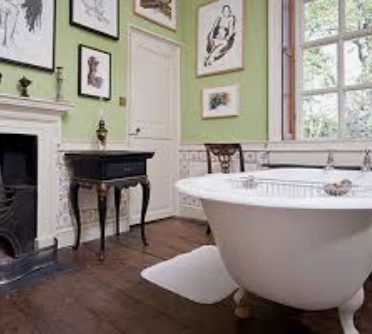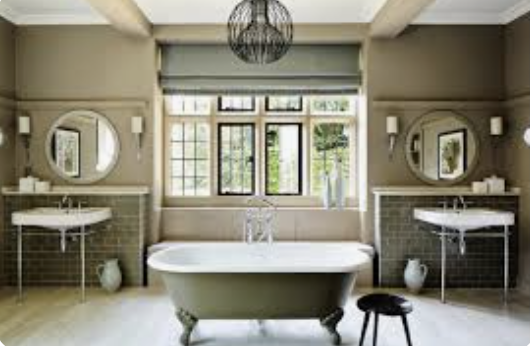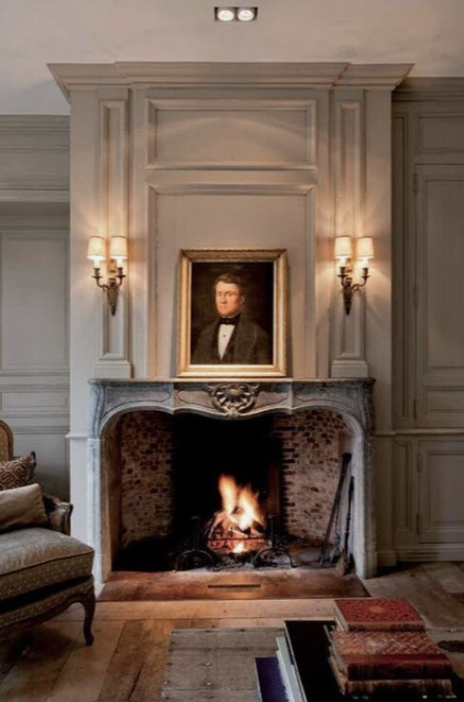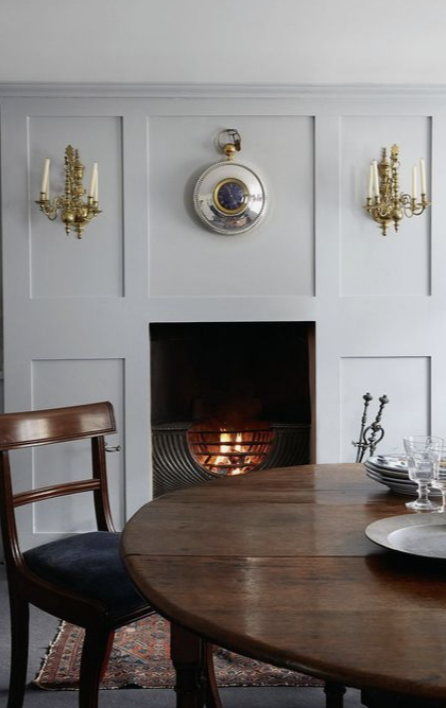A GUIDE TO RENOVATING GEORGIAN PROPERTY
Renovating a Georgian property is both a challenge and a pleasure, There are many features which make up a typical Georgian home, this guide will talk you through what you need to consider when renovating one.
The Georgian era ranged from 1714 - 1837, Typical Georgian features include large tall windows, high ceilings, simple and elegant design, symmetry and classical proportions. Installing mod cons sympathetically is part of the renovation process, to make your home comfortable.
Many Georgian houses are listed, If you live in a listed property check with your local planning office that all changes will be approved.
Throughout the house: Replace radiators with cast iron period column radiators for a sympathetic historical look, although not Georgian they will work well with Georgian style.
The Grand Hallway: Making an Entrance
The hallway of a Georgian home gives you the first impression, setting the tone for what’s to come. When you walk through the door, you want to feel the hallway is inviting grand and elegant.
Restoring Cornices and Mouldings: Georgian hallways often feature beautiful plaster mouldings and cornices. These might have been hidden under layers of paint or damaged over the years. If any details are missing, a skilled plaster specialist can recreate them to match the original design. It is also possible to buy plaster reproduction to replace what might no longer be there.
Flooring: If your Georgian hallway has its original black-and-white chequered flooring or flagstones, restoring these adds a real sense of history. If they’re beyond saving, you can find materials like reclaimed stone or wood or tiles to keep the period look authentic.
Lighting: The hallway needs to feel welcoming. You could install a grand chandelier or subtle wall lights, but keep the fixtures classic . Brass or wrought-iron finishes work well, complementing the historical feel.
Colour Palette: Georgian hallways were often painted in soft, neutral tones like pale creams, warm greys, and muted greens. These colours help to reflect light and make the hallway feel spacious and elegant.
Furniture : If the hallway is big enough install a statement antique chair, console table and accessorise with a mirror and artworks.
The Living Room: Restoring Elegance
Living rooms in Georgian homes were designed to impress, and the key to restoring this space is all about balance – keeping the period features, but making it cosy and liveable.
Fireplaces: A grand Georgian fireplace is the heart of the living room. Restoring an original marble or cast-iron fireplace can make a huge difference. If the original fireplace is gone, source a reclaimed or reproduction fireplace surround.
Cornices and Ceiling Roses: The ceiling details in Georgian homes are works of art in themselves. If your living room has intricate cornices or a beautiful ceiling rose, they should be restored carefully. If they’ve been lost over time, you can buy them from a specialist plaster shop.
Sash Windows: The tall, elegant sash windows are one of the standout features of Georgian properties. Restoring the original sash windows – complete with their pulleys and weights – is important to maintain the character of the room. They can be draught-proofed without losing any of their charm. If the window is deep enough an additional pain of glass can be installed to make the window double glazed.
Flooring: Polished wooden floors were a typical feature of Georgian dining rooms. If you have original floorboards, restore them to their former glory. If not, opt for period-style flooring that complements the room’s formal feel. Choose a large oriental wool rug to make the room feel cosy
Colours: Choose soft, muted tones like pale greys, soft greens, muted pinks or dusty blues for the living room. These colours were popular in Georgian times and will help the room feel calm and elegant, while also letting the period details shine.
Lighting: Install a beautiful chandelier, and wall sconces, they are like jewellery on a beautiful woman, and will complement the beauty of the room. A glass or crystal antique chandelier or a modern Murano chandelier all work in this space.
Furnishing a Georgian Lining room; Using reupholstered Regency or Georgian antique sofas and armchairs would be very appropriate. Also carefully chosen modern pieces, accessorised with antique mirrors and artworks modern or traditional .
The Dining Room:
In a Georgian home, the dining room was often a formal space for entertaining. Restoring this room gives you the chance to embrace the grand, slightly dramatic atmosphere that was common at the time.
Fireplace: As in the living room, the fireplace is key. Restoring or replacing it with a period-appropriate stone or marble surround adds instant impact.
Wall Panelling and Mouldings: Many Georgian dining rooms featured wall panelling or dado rails, along with decorative plaster mouldings. If these features are missing, it’s worth considering adding them back. They bring depth and character to the room.
Flooring: Polished wooden floors were a typical feature of Georgian dining rooms. If you have original floorboards, restore them to their former glory. If not, opt for period-style flooring that complements the room’s formal feel.
Rich Colours: Georgian dining rooms often used dramatic, darker tones like deep reds, dark greens, and rich blues. These colours give the room a warm, intimate feel.
Furnishing: A beautiful antique table and chairs would look beautiful in this room, and could be reupholstered to match the scheme. Alternatively a modern table and chairs chosen for the space would also work well. Again beautiful lighting, a chandelier and wall sconces are essential in this room.
The Heritage-Style Kitchen: A Mix of Old and New
Georgian kitchens were vastly different from the ones we’re used to today. So, when renovating, it’s important to blend the old with the new, creating a kitchen that’s practical but still fits in with the rest of the house.
Cabinetry: Look for shaker-style cabinets – they’re timeless and work beautifully in a heritage-style kitchen. Painted in soft colours like sage green, cream, or light grey, they look classic but offer all the modern storage solutions you need. Handles should be chosen in heritage materials, pewter, brass or copper, and chosen well will enhance the cabinetry.
Fireplace or Hearth: Many Georgian kitchens had large hearths. If yours still has one, it’s worth restoring, even if it’s just as a feature. You could use it to frame a modern range cooker or keep it as a decorative nod to the past.
Worktops and Splash backs: Use natural materials like wood, marble, or stone for the worktops. These materials feel warm and authentic, fitting seamlessly into the period style. For splash backs, simple tiles or natural stone add a subtle but effective touch.
Flooring: A kitchen with stone or wood floors will feel instantly grounded in history. Limestone or flagstone flooring is practical and long-lasting, while wide, reclaimed oak boards give the room a rustic yet refined look.
Colours: Soft heritage tones like off-whites, greys, greens or subtle blues will help the kitchen feel light and airy, while still staying true to the Georgian period.
Lighting: The Lights could be pendants or a traditional style light fitting matched to the metal handles used on cabinetry.
Furnishing: A reclaimed farmhouse table and chairs, or bench seating would work best in this space. Also consider a modern table and chairs as a juxtaposition to the traditional. Roman blinds would complement as a window treatment.
The Bedrooms: Simple and Serene
Bedrooms in Georgian homes tend to be more understated, with simpler features compared to the grander living spaces. Restoring them is about creating a calm, comfortable space that still reflects the history of the home.
Fireplaces: Many Georgian bedrooms have small, cast-iron fireplaces. Restoring these can add an elegant focal point to the room, even when they’re no longer in use.
Mouldings and Plasterwork: While the decorative plasterwork in bedrooms is often less elaborate than in other rooms, it’s still important to restore or recreate the original mouldings to keep the period feel intact.
Sash Windows: Like the rest of the house, the sash windows in the bedrooms should be carefully restored. Ensuring they work properly and are draught-proofed will help make the room comfortable without losing any of its character.
Colour Scheme: For bedrooms, choose soft, restful tones like pale blues, soft pinks light greys, or creams. These colours create a peaceful atmosphere, in keeping with the simplicity and elegance of Georgian design.
Furnishings: Either use antique beds or a divan with a statement headboard, antique or modern bedside tables, chosen for their simple craftsmanship, with turned details. If there’s room add softly upholstered armchair. Accessorise with oriental woollen rugs mirrors and picture frames, some wall lights and smaller chandeliers should be considered.
The Bathroom: Modern Comfort with a Period Twist
Bathrooms as we know them didn’t exist in Georgian homes, so this space requires a thoughtful approach. You want modern convenience but with a nod to the past.
Sanitary ware: Opt for Victorian-style fittings, like a freestanding clawfoot bathtub and a traditional pedestal sink. An antique chest of draws can also be used as a base for a sink. These aren’t strictly Georgian, but they evoke a classic feel that fits well with the rest of the house. Shower fittings should be open pipework Victorian style.
Flooring: Go for natural stone, marble, or traditional floor tiles. Geometric black-and-white patterns or simple stone finishes will keep the bathroom in line with the home’s historical charm.
Colours: Keep the bathroom light and fresh with soft whites, light greys, green or subtle blues. Brass, copper or nickel fittings also add a classic touch.
Bringing It All Together
Renovating a Georgian property is all about balancing the old with the new. By restoring original features like mouldings, fireplaces, and sash windows, and carefully introducing modern comforts, you can create a home that feels both timeless and practical.Every room has its own character, and by using historically appropriate paint colours, natural materials, and sympathetic design choices, you can respect the heritage of the house while making it your own. It’s a delicate process, but when done well you will have a rewarding and beautiful result.




















